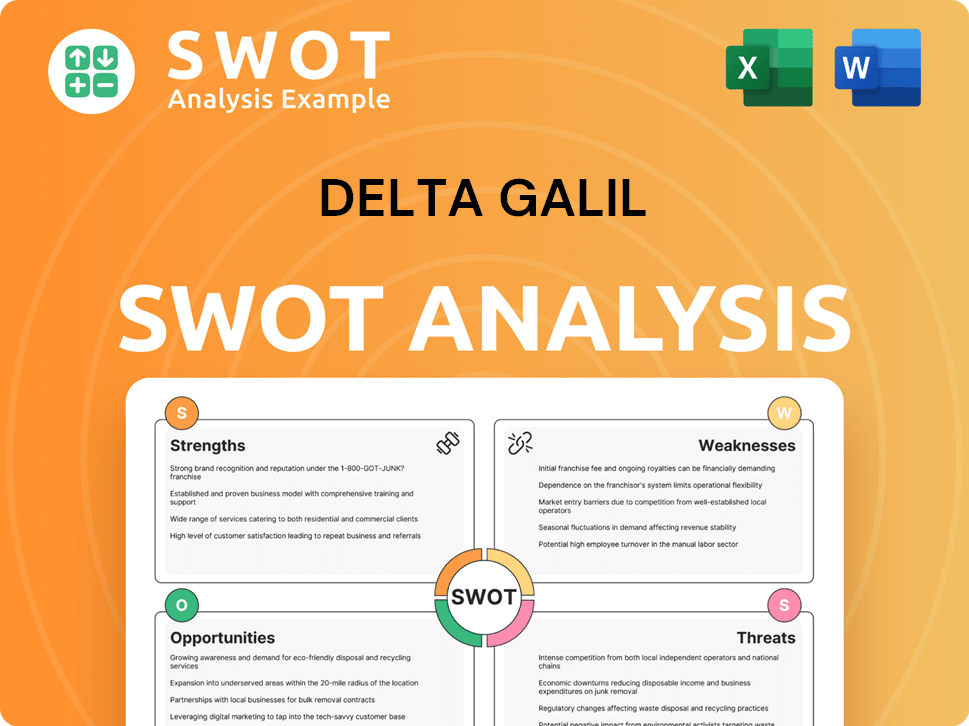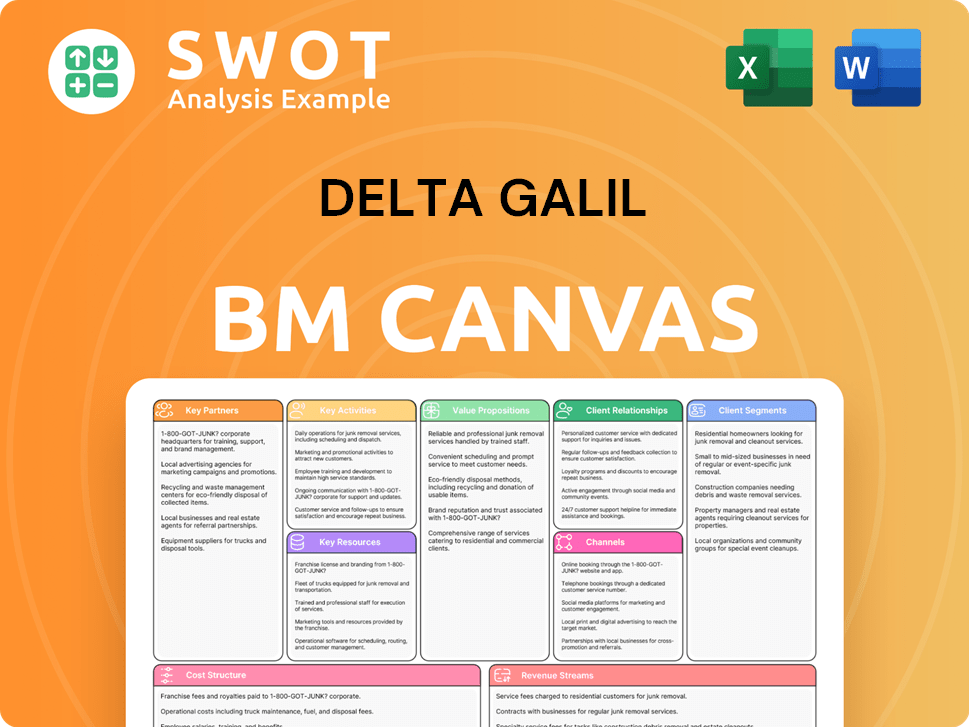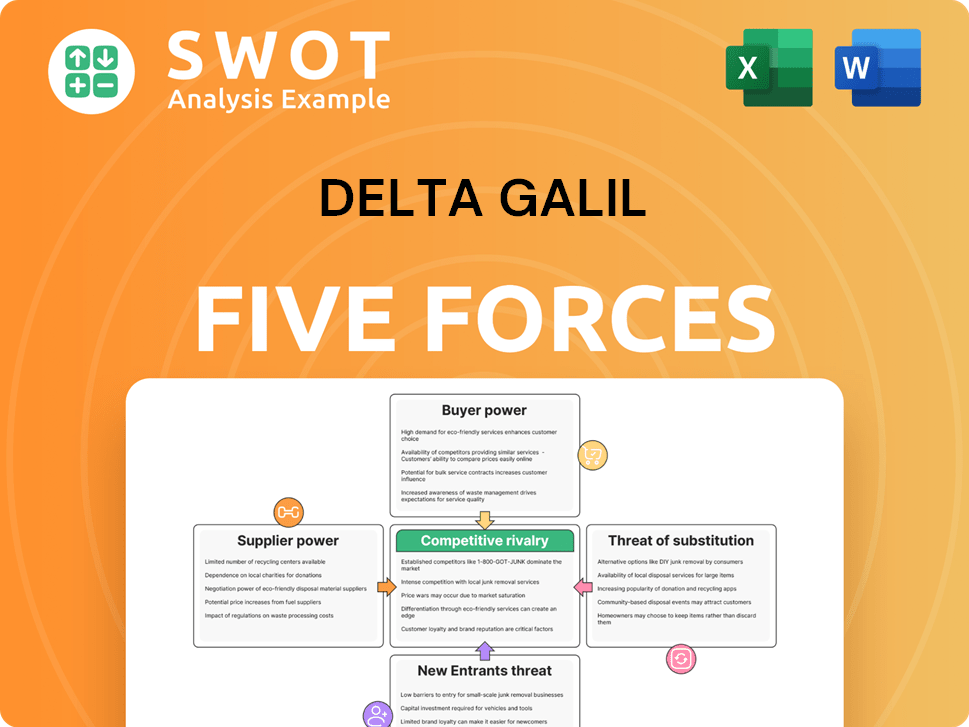Delta Galil Bundle
How Did Delta Galil Become a Global Apparel Powerhouse?
Delta Galil Industries, a prominent player in the apparel industry, has a fascinating story of growth and innovation. From its beginnings as an Delta Galil SWOT Analysis to its current global presence, the company's journey is marked by strategic decisions and a commitment to quality. Discover how this Israeli company transformed from a small startup into a leader in textile manufacturing.

This brief history of Delta Galil will explore the key milestones that shaped the company. Learn about the Delta Galil founding date, its expansion into diverse product lines, and the strategic acquisitions that fueled its growth. Understand how Delta Galil's focus on sustainable practices and its global manufacturing footprint contributed to its success in the competitive apparel industry.
What is the Delta Galil Founding Story?
The story of Delta Galil, a prominent player in the global apparel industry, began in 1975. Founded by Dov Lautman in Israel, the company emerged from a vision to create a vertically integrated textile operation. This approach allowed for comprehensive control over the production process, from raw materials to finished products, ensuring both quality and efficiency.
Lautman, an engineer with a deep understanding of the textile sector, saw an opportunity in the intimate apparel and hosiery markets. His initial focus was on manufacturing high-quality cotton underwear and socks. This product line met the growing demand for comfortable and durable everyday wear. The company's name, 'Delta Galil,' likely reflects progression and its connection to the Galilee region in Israel.
Early funding for Delta Galil came from Lautman's personal resources and initial investments. Lautman's expertise in production and his commitment to innovation were crucial in overcoming the initial challenges of establishing a manufacturing operation in a developing market. The cultural and economic context of Israel in the mid-1970s provided a fertile ground for the venture. This allowed Delta Galil to capitalize on available skilled labor and a supportive business environment. Learn more about the Owners & Shareholders of Delta Galil.
Delta Galil's founding marked the beginning of a significant journey in the apparel industry.
- Founding Date: 1975
- Founder: Dov Lautman
- Initial Focus: Manufacturing high-quality cotton underwear and socks.
- Business Model: Vertically integrated textile company.
- Location: Israel.
Delta Galil SWOT Analysis
- Complete SWOT Breakdown
- Fully Customizable
- Editable in Excel & Word
- Professional Formatting
- Investor-Ready Format

What Drove the Early Growth of Delta Galil?
The early growth of the Delta Galil company, an Israeli company, was marked by strategic product line expansions and a strong manufacturing base. In the late 1970s and early 1980s, the company diversified beyond basic underwear and socks into sleepwear and leisurewear. Investments in advanced manufacturing technologies enhanced production efficiency and product quality.
Delta Galil expanded its product offerings beyond underwear to include sleepwear and leisurewear. This diversification helped the company to capture a broader market segment within the apparel industry.
Investments in advanced manufacturing technologies were crucial. These investments improved production efficiency and ensured high product quality, which was key to meeting the demands of both retailers and consumers.
The establishment of international sales offices and manufacturing facilities, particularly in Europe, was a pivotal step. This allowed Delta Galil to serve a wider customer base and optimize its supply chain, enhancing its global presence.
Securing licenses for prominent international brands became a cornerstone of Delta Galil's growth strategy. Entering markets in the United States and Asia further solidified its global footprint. Initial public offerings provided capital for further expansion and acquisitions.
Leadership transitions during this period focused on strengthening the company's international management team. The market reception was largely positive, as Delta Galil's emphasis on quality, innovation, and efficient production resonated with both retailers and consumers. The competitive landscape spurred continuous innovation, leading to strategic shifts towards becoming a comprehensive apparel solutions provider. For more on the company's values, consider reading about the Mission, Vision & Core Values of Delta Galil.
Delta Galil PESTLE Analysis
- Covers All 6 PESTLE Categories
- No Research Needed – Save Hours of Work
- Built by Experts, Trusted by Consultants
- Instant Download, Ready to Use
- 100% Editable, Fully Customizable

What are the key Milestones in Delta Galil history?
The Delta Galil history is marked by significant milestones, including strategic partnerships and expansions. A key aspect of the Delta Galil company's journey has been its ability to adapt and innovate within the dynamic apparel industry.
| Year | Milestone |
|---|---|
| 1975 | Founded as a textile manufacturer in Israel. |
| 1990s | Expanded its operations and began forming partnerships with major global brands. |
| 2000s | Continued to grow its global presence, establishing manufacturing facilities and distribution networks worldwide. |
| 2020 | Acquired Bare Necessities, enhancing its online presence and expanding its intimate apparel offerings. |
| 2023 | Reported a revenue of $2.05 billion, demonstrating its strong market position. |
Delta Galil has consistently invested in fabric technology and garment construction, leading to proprietary materials. This focus on innovation has resulted in numerous patents and a leadership position in performance-driven apparel.
Development of advanced fabrics that offer enhanced comfort, breathability, and durability. This includes materials designed for specific performance needs, such as moisture-wicking and temperature regulation.
Innovations in garment design and construction techniques to improve fit, functionality, and aesthetics. This involves the use of advanced sewing and manufacturing processes.
Implementation of sustainable manufacturing processes and the use of eco-friendly materials. This includes initiatives to reduce water usage, waste, and carbon emissions.
Investing in e-commerce platforms and digital marketing strategies to enhance online sales and customer engagement. This includes data analytics to understand consumer behavior and preferences.
Expanding product lines to include a wider range of apparel categories, such as activewear, intimates, and licensed products. This diversification helps to mitigate risks and capture new market opportunities.
Improving the efficiency and resilience of its global supply chain through strategic partnerships and investments in technology. This includes initiatives to enhance traceability and transparency.
The Delta Galil company has faced market downturns and intense competition, particularly from direct-to-consumer brands. Managing a global supply chain and adapting to evolving consumer preferences for sustainable products have also been continuous challenges.
Economic recessions and fluctuations in consumer spending have periodically impacted demand for apparel. Delta Galil has had to adapt to changing market conditions to maintain profitability.
Intense competition from both established players and emerging direct-to-consumer brands has required constant innovation and strategic adjustments. The apparel industry is highly competitive.
Managing a complex global supply chain, including sourcing materials, manufacturing, and distribution, presents significant challenges. Disruptions can impact production and profitability.
Adapting to the fast-evolving e-commerce landscape and consumer preferences for online shopping requires significant investment in digital capabilities. This includes enhancing online presence and marketing strategies.
Meeting the increasing demand for sustainable products and practices requires investment in eco-friendly materials and manufacturing processes. This includes reducing environmental impact and promoting ethical sourcing.
Managing rapid expansion and integrating acquired companies has required strategic restructuring and leadership adjustments. Efficient integration is crucial for realizing the full potential of acquisitions.
For a more detailed look at the company, you can read this Delta Galil company profile.
Delta Galil Business Model Canvas
- Complete 9-Block Business Model Canvas
- Effortlessly Communicate Your Business Strategy
- Investor-Ready BMC Format
- 100% Editable and Customizable
- Clear and Structured Layout

What is the Timeline of Key Events for Delta Galil?
The Delta Galil history is marked by strategic acquisitions and global expansion, starting with its founding in Israel. Over the years, the Israeli company has grown significantly, diversifying its product lines and entering new markets. This expansion included entering the US market and initiating licensing agreements with international brands. The company's journey reflects its adaptability and commitment to innovation within the apparel industry.
| Year | Key Event |
|---|---|
| 1975 | Founded in Israel by Dov Lautman. |
| 1980s | Expanded into European markets and diversified product lines, showcasing early growth in textile manufacturing. |
| 1990s | Entered the US market and began licensing agreements with major international brands. |
| 2005 | Acquired the Schiesser Group, a prominent European intimate apparel brand. |
| 2009 | Acquired the apparel division of J.C. Penney. |
| 2011 | Acquired P.J. Salvage, a premium loungewear brand. |
| 2012 | Acquired the LittleMissMatched brand. |
| 2017 | Acquired assets of VF Corporation's Contemporary Brands business, including 7 For All Mankind, Splendid, and Ella Moss. |
| 2020 | Acquired Bare Necessities, an online intimate apparel and swimwear retailer, boosting e-commerce capabilities. |
| 2022 | Continued focus on sustainability initiatives and digital transformation. |
| 2023-2024 | Focused on enhancing profitability, optimizing supply chains, and expanding direct-to-consumer channels; reported a net income of $50.3 million for 2023, with sales reaching approximately $1.8 billion. |
Delta Galil plans to further expand its global market presence, particularly in emerging markets. This includes exploring new geographic areas and increasing its footprint in existing markets. The company aims to capitalize on rising consumer demand in various regions.
Investing in innovation is a key focus, especially in developing new performance fabrics and sustainable production methods. The company is committed to integrating sustainable practices throughout its operations. This includes reducing its environmental impact and promoting ethical sourcing.
Delta Galil aims to strengthen its direct-to-consumer channels, building on the success of the Bare Necessities acquisition and other digital platforms. This strategic move allows for greater control over customer experience and brand messaging. The company plans to enhance its online retail presence.
Leveraging data analytics to better understand consumer preferences and optimize product development and inventory management is a priority. This data-driven approach helps the company make informed decisions. It also improves efficiency across the supply chain.
Delta Galil Porter's Five Forces Analysis
- Covers All 5 Competitive Forces in Detail
- Structured for Consultants, Students, and Founders
- 100% Editable in Microsoft Word & Excel
- Instant Digital Download – Use Immediately
- Compatible with Mac & PC – Fully Unlocked

Related Blogs
- What is Competitive Landscape of Delta Galil Company?
- What is Growth Strategy and Future Prospects of Delta Galil Company?
- How Does Delta Galil Company Work?
- What is Sales and Marketing Strategy of Delta Galil Company?
- What is Brief History of Delta Galil Company?
- Who Owns Delta Galil Company?
- What is Customer Demographics and Target Market of Delta Galil Company?
Disclaimer
All information, articles, and product details provided on this website are for general informational and educational purposes only. We do not claim any ownership over, nor do we intend to infringe upon, any trademarks, copyrights, logos, brand names, or other intellectual property mentioned or depicted on this site. Such intellectual property remains the property of its respective owners, and any references here are made solely for identification or informational purposes, without implying any affiliation, endorsement, or partnership.
We make no representations or warranties, express or implied, regarding the accuracy, completeness, or suitability of any content or products presented. Nothing on this website should be construed as legal, tax, investment, financial, medical, or other professional advice. In addition, no part of this site—including articles or product references—constitutes a solicitation, recommendation, endorsement, advertisement, or offer to buy or sell any securities, franchises, or other financial instruments, particularly in jurisdictions where such activity would be unlawful.
All content is of a general nature and may not address the specific circumstances of any individual or entity. It is not a substitute for professional advice or services. Any actions you take based on the information provided here are strictly at your own risk. You accept full responsibility for any decisions or outcomes arising from your use of this website and agree to release us from any liability in connection with your use of, or reliance upon, the content or products found herein.